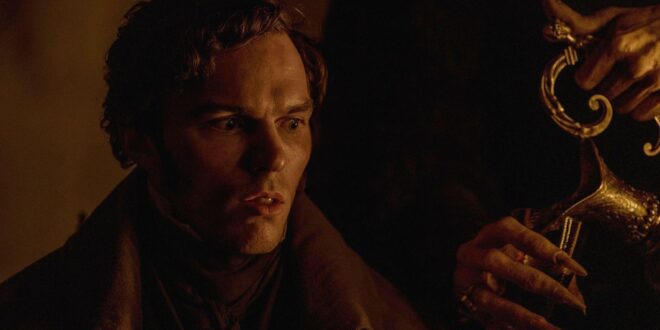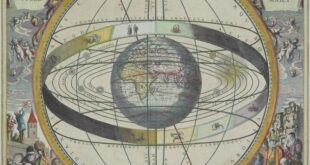Thomas (Nicholas Hoult) in Robert Eggers’ ‘Nosferatu’
UNIVERSAL
Robert Eggers’
Nosferatu
resurrects the classic vampire story for a new generation, and stays faithful to the 1922 original film, which is steeped in occult symbolism.
Eggers’ Nosferatu stars Lily-Rose Depp as Ellen Hutter, who summons the ancient vampire known as Count Orlok (Bill Skarsgård) through her mysterious connection to the spirit realm.
Eggers has an incredible gift for bringing the past to life, in no small part due to his dedication to historical accuracy.
Eggers took inspiration from ancient vampire folklore, as well as occult imagery and ideas, to ensure his adaptation matched the eerie tone of the original film.
The Original ‘Nosferatu’ Contained Occult Symbolism
The inspiration for the 1922 Nosferatu: A Symphony of Horror was born out of the horrors of WWI, with the mass death, disease and rat-infested trenches mirroring the conditions that Count Orlok inflicts on the townsfolk.
Nosferatu’s director F. W. Murnau, producer Albin Grau, and star Max Schreck (who played Count Orlok) all fought in the war, enduring the terrible conditions of the trenches.
The end of First World War coincided with a rise in spiritualism and occultism, and Grau was a dedicated occultist who claimed to have been inspired by a strange encounter he had with a farmer on the Serbian front, who believed that his father had risen from the grave and become a vampire.
Grau helped design Nosferatu’s sets, costumes, and the iconic makeup that transformed Schreck into Count Orlok. Grau filled the film with occult themes, such as the idea that the vampire could only be defeated by a blood sacrifice.
Grau also ensured that a contract between Orlok and his assistant that appears onscreen featured occult and alchemical markings, as well as Enochian symbols, said to be the language of angels.
Grau imbued Orlok with an occult origin, as the vampire is said to have sprung from “the Seed of Belial,” a demon who is one of the lords of Hell, and associated with disease.
In modern pop culture, vampires have strayed away from occultism and are often depicted through a Christian lens, being repelled by crucifixes and sunlight. However, Nosferatu is the first film to depict a vampire dying from sunlight exposure.
Max Schreck, who was something of an eccentric, gave a striking performance as Orlok and inspired many bizarre rumors after his death, with some even speculating that the actor was a real vampire.
This legend inspired a feature film, a fictional account of the making of Nosferatu, with Willem Dafoe starring as the vampiric Schreck (ironic, given that Dafoe also appears in Eggers’ adaptation).
While the original Nosferatu is actually an unauthorized adaptation of Bram Stoker’s Dracula, the ghoulish Count Orlok is quite different from Count Dracula’s charming, handsome nobleman.
Orlok is closer to the earlier vampiric legends of Europe, which depict the creatures as more ethereal and corpse-like than Dracula.
The ‘Nosferatu’ Remake Pays Tribute To The Original Film’s Folkloric And Occultist Roots
In Robert Eggers’ film, there are many references to occultism, folklore and religion.
When Ellen’s husband, Thomas (Nicholas Hoult), arrives in Romania, the locals appear to understand how to deal with vampire plagues, and enact a historical folk ritual to find the grave of a lesser vampire.
Thomas watches as a naked virgin rides a horse, which is meant to stumble upon reaching the grave of a vampire. Sure enough, the villagers uncover one of the creatures and slay it by using a stake.
Count Orlok, however, appears to be quite a different breed of vampire, and is not so easily dealt with.
In Orlok’s castle, an occult contract covered in magical symbols makes an appearance, as it does in the original film. Orlok demands that Thomas sign the contract, a promise to let the vampire take Ellen.
Orlok is given a different demonic origin, as an Orthodox nun tells Thomas that the Count sold his soul to the Devil and dabbled in black magic during his life.
This incarnation of Orlok is something of an outlier in vampire cinema, as he is dressed in the period-accurate robes of a Transylvanian nobleman, complete with the mustache that was the fashion of his time.
Thomas appears to be safe in the sanctuary of the nuns, but flees back to Wisborg to warn Ellen, who has summoned the creature due to her “impure” desires and loneliness.
Notably, Orlok wants to go to Wisborg not only for Ellen, but to enter a space where the inhabitants put their faith in science and God, as the Germans lack the traditional folk knowledge of the Romanians.
Knock prepares for his master’s arrival by scrawling magical, occult symbols all over his prison walls, while the city prays for mercy that never comes.
The only one capable of countering the threat is the occultist professor, Albin Eberhart Von Franz (Willem Dafoe), who understands that Ellen can be saved—or rather, sacrificed, to prevent Orlok’s deadly disease from spreading.
While Ellen’s spasms and fits are viewed as shameful by her peers—even her husband—Franz views her as a sacred figure who would have been a high priestess in another age.
At one point, Knock describes Ellen as a “sylph,” a mystical air spirit described by the alchemist Paracelsus.
Ellen is a figure born out of time, and it’s only by taking control of the situation that she can purify the town of Orlok’s plague, the occult blood sacrifice that closes the original film.
The original Nosferatu still stands as a genuinely unnerving piece of cinema, and it’s something of a miracle that it exists at all, as all copies were ordered to be destroyed after the film’s creators lost a copyright violation lawsuit to Stoker’s widow.
A few copies survived, despite the odds, and were widely distributed across the world after the copyright to Stoker’s Dracula expired.
Almost like a real vampire, Nosferatu suffered something of a “death” before being resurrected, becoming one of the foundational pillars of modern vampire lore.
MORE FROM FORBES
 Mind Uncharted Explore. Discover. Learn.
Mind Uncharted Explore. Discover. Learn.



